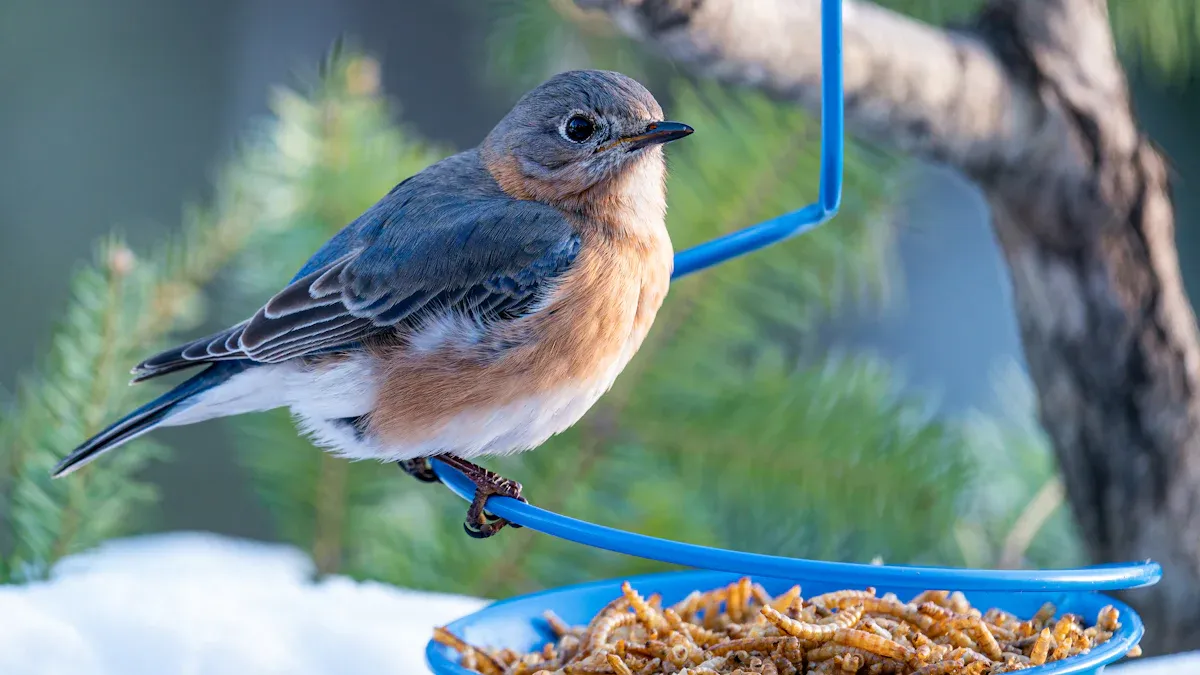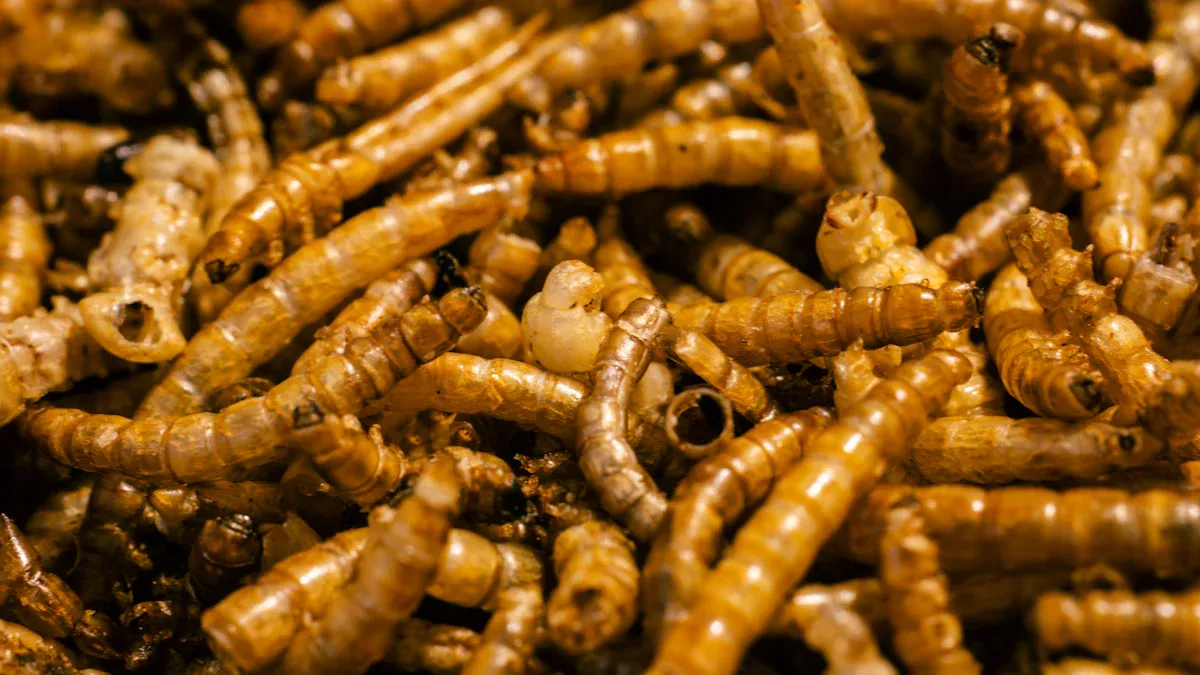
Bluebirds love a good meal, and dry mealworms for bluebirds are a fantastic choice. These tiny treats pack a punch of protein, fat, and fiber, keeping the birds healthy and active. Offering mealworms mimics their natural diet, making it easier to attract them to your yard and support their well-being year-round.
Key Takeaways
- Dried mealworms are healthy for bluebirds. They have protein, fats, and fiber to keep them strong and energetic.
- Feeding dried mealworms is like their natural food. It helps attract bluebirds to your yard and keeps them happy.
- Use a good feeder and give small amounts. This helps bluebirds eat a balanced diet and stay healthy all year.
Why Dry Mealworms For Bluebirds Are a Healthy Choice
High Protein Content for Energy and Growth
Protein plays a vital role in helping bluebirds stay active and healthy. Dry mealworms for bluebirds are packed with protein, making them an excellent energy source. Studies show that high-protein diets can increase bluebird brood size by 5% and improve hatching success. This makes dried mealworms especially beneficial during the breeding season when birds need extra energy for nesting and raising their young. By offering these protein-rich treats, bird enthusiasts can support bluebirds’ growth and vitality.
Rich in Fats and Fiber for Overall Health
In addition to protein, dried mealworms contain healthy fats and fiber. These nutrients help bluebirds maintain their energy levels and support their digestive health. The fat content in dried mealworms provides a concentrated energy source, which is particularly useful during colder months when food is scarce. Fiber, on the other hand, aids digestion and ensures the birds can process their meals efficiently. Including dried mealworms in their diet helps bluebirds stay strong and resilient throughout the year.
Mimics the Natural Diet of Bluebirds
Bluebirds naturally feed on insects, making dried mealworms a familiar and appealing food option. These mealworms closely resemble the insects bluebirds would find in the wild, ensuring they meet the birds’ dietary needs. While live mealworms provide hydration, dried mealworms offer a more convenient alternative with similar nutritional benefits. They are also easier to store and serve, making them a practical choice for bird lovers. By mimicking their natural diet, dried mealworms encourage bluebirds to visit and thrive in your yard.
Practical Benefits of Dry Mealworms For Bluebirds
Long Shelf Life and Easy Storage
Dried mealworms are a practical choice for bird enthusiasts because of their long shelf life. Unlike live mealworms, which need refrigeration to stay fresh, dried mealworms can be stored in an air-tight container. This makes them easier to manage and less dependent on specific storage conditions. However, they should be kept away from heat and moisture to prevent spoilage. For those who want to stock up, dried mealworms can even be stored in a freezer or refrigerator for extended freshness. Their durability and ease of storage make them a budget-friendly option compared to live alternatives.
Convenient and Mess-Free Feeding
Feeding bluebirds dried mealworms is a hassle-free experience. They don’t wriggle around like live mealworms, making them easier to handle and serve. Bird feeders often appreciate how clean and straightforward it is to offer dried mealworms. Some bluebirds may prefer live mealworms, but many will happily accept dried ones, even feeding them to their young. This convenience allows bird lovers to enjoy the experience without dealing with the mess or maintenance of live insects.
Reliable Food Source in All Seasons
Dried mealworms provide a consistent food source for bluebirds throughout the year. During colder months, when insects are scarce, they offer a reliable alternative to natural prey. Their high protein and fat content help bluebirds maintain energy and stay healthy, even in challenging weather. By offering dried mealworms, bird enthusiasts can ensure their feathered friends always have access to nutritious food, no matter the season.
Feeding Tips for Dry Mealworms For Bluebirds

Choosing the Right Feeder
Selecting the right feeder is essential for successfully offering dry mealworms to bluebirds. A good feeder should be durable, easy to clean, and designed specifically for small birds. Look for feeders with openings between 1.5 to 1.75 inches to keep larger birds out while allowing bluebirds to access the food. A removable tray is also helpful as it prevents mealworms from spilling and makes cleaning easier.
| Feeder Features | Description |
|---|---|
| Material | Weather-resistant and long-lasting. |
| Entrance Size | 1.5″ to 1.75″ openings to exclude larger birds. |
| Roof | Protects mealworms from rain and sun. |
| Ease of Use | Simple to fill and clean, even with one hand. |
| Versatility | Can also hold suet or berries. |
Investing in a quality feeder ensures bluebirds can enjoy their mealworms safely and conveniently.
Attracting Bluebirds to Your Yard
Attracting bluebirds takes a little effort, but it’s worth it. Brightly colored feeders or those with reflective surfaces can catch their attention. Adding sounds, like wind chimes, may also help. Bluebirds prefer live mealworms, but rehydrating dried ones by soaking them in warm water can make them more appealing. Place the feeder in an open area, away from dense trees or shrubs, to reduce the risk of predators.
Tip: Moderation is key. Feeding too many mealworms can lead to health issues, especially for young birds. Balance their diet with other food sources.
In suburban areas, bluebirds have shown higher survival rates when mealworms are provided, especially during harsh weather. This makes your yard a safe haven for these beautiful birds.
Combining Mealworms with Other Foods
Dry mealworms for bluebirds are nutritious, but they lack calcium, which is vital for nestlings. To create a balanced diet, combine mealworms with other foods like suet, berries, or calcium-enriched supplements. Mixing mealworms into a birdseed blend can also encourage bluebirds to feed.
- Suggestions for a Balanced Diet:
- Add crushed eggshells or calcium powder to the feeder.
- Offer live mealworms occasionally for hydration.
- Include fruits like raisins or chopped apples.
This variety ensures bluebirds get the nutrients they need to stay healthy and thrive in your yard.
Are Dry Mealworms For Bluebirds Safe?
Ensuring Quality and Avoiding Additives
When choosing dried mealworms, quality matters. Not all products are created equal, and some may contain harmful additives or preservatives. Bluebird enthusiasts should look for mealworms labeled as 100% natural. These options ensure the birds receive a safe and nutritious treat without unnecessary chemicals. Checking the packaging for freshness and avoiding mealworms with an unusual smell or discoloration can also help maintain safety.
Tip: Buying from reputable brands or suppliers reduces the risk of contamination or low-quality products.
Feeding in Moderation for Balanced Nutrition
While dried mealworms are a great source of protein and energy, moderation is key. Overfeeding can lead to health issues for bluebirds, especially for nestlings. Dried mealworms have a tough exoskeleton that can be hard for young birds to digest. They also lack essential nutrients like calcium, which is critical for bone development.
- Potential risks of overfeeding dried mealworms:
- Intestinal blockage due to their low nutritional value.
- Dehydration and constipation in nestlings.
- Malnutrition caused by filling up on hard-to-digest materials.
To ensure a balanced diet, pairing dried mealworms with calcium-rich foods like crushed eggshells or suet is a smart choice.
Addressing Common Concerns About Dried Mealworms
Some bird lovers worry about the safety and effectiveness of feeding dried mealworms. Studies show that bluebirds prefer live mealworms over dried ones, but soaking dried mealworms in warm water can make them more appealing. Another concern is the potential for habitat dependency. Birds may rely too heavily on feeders if mealworms are offered excessively.
Other issues include predator exposure and disease transmission. Placing feeders in open areas and cleaning them regularly can minimize these risks. Feeding in moderation and offering a variety of foods ensures bluebirds stay healthy and independent.
Dry Mealworms For Bluebirds are a smart choice for bird enthusiasts. They’re packed with nutrients, easy to store, and attract these colorful birds to your yard. Offering mealworms regularly helps bluebirds stay healthy and active. It’s a simple way to support their well-being while enjoying their beauty and cheerful songs.
FAQ
How often should you feed bluebirds dried mealworms?
Feed bluebirds dried mealworms once or twice daily. Offer small portions to avoid overfeeding and ensure they maintain a balanced diet with other natural food sources.
Can dried mealworms attract other bird species?
Yes, dried mealworms can attract other birds like robins, wrens, and chickadees. To focus on bluebirds, use feeders designed specifically for small birds.
Should dried mealworms be soaked before feeding?
Soaking dried mealworms in warm water softens them and adds moisture. This makes them easier to digest, especially for young bluebirds or during hot weather.


